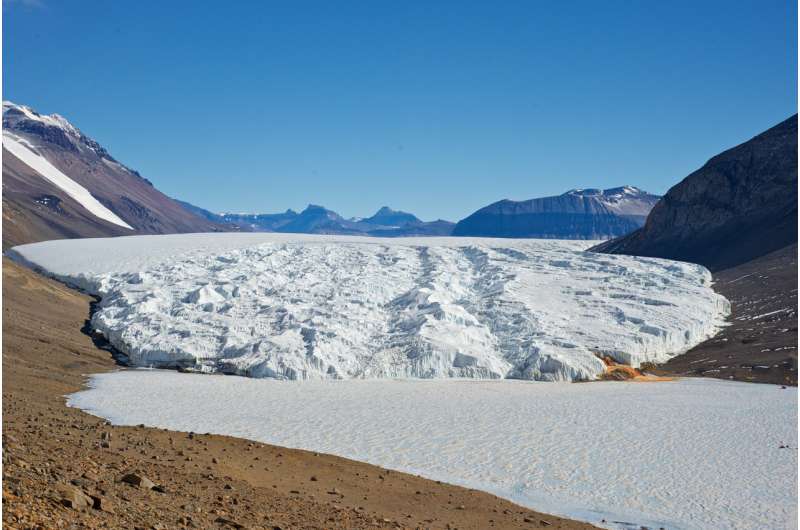Ancient gene family protects algae from salt and cold in an Antarctic lake

Glycerol, used in the past as antifreeze for cars, is produced by a range of organisms from yeasts to vertebrates, some of which use it as an osmoprotectant—a molecule that prevents dangerous water loss in salty environments—while others use it as an antifreeze. Here, scientists from the University of Nevada and Miami University in Ohio show that two species of the single-celled green algae Chlamydomonas from Antarctica, called UWO241 and ICE-MDV, produce high levels of glycerol to protect them from osmotic water loss, and possibly also from freezing injury. Presently, only one other organism, an Arctic fish, is known to use glycerol for both purposes. Both species synthesize glycerol with enzymes encoded by multiple copies of a recently discovered ancient gene family. These results, published today in the open-access journal Frontiers in Plant Science, illustrate the importance of adaptations that allow life to not only survive but to thrive in extreme habitats.
The researchers collected both Chlamydomonas species from depths of 13 to 17 m, a region with a steep salinity gradient, in Lake Bonney, a permanently ice-covered lake in the McMurdo Dry Valleys of Victoria Land, Antarctica. Previously, they showed that both species are remarkably adapted to their extreme habitat, with a photosynthetic apparatus adapted to cold, saline, and light-poor conditions, novel proteins, more fluid cell membranes that function at low temperatures, and ice-binding proteins that protect against freeze-thaw injury.
"Our overall goal is to understand how microorganisms survive in extreme environments. The Chlamydomonas species of Lake Bonney are well-suited for such studies because they are exposed to many extremes, including low light, low temperature, oxidative stress, and high salinity. The present results are the first to show that glycerol production by microorganisms, which is well-known in warm, salty environments, is also important in polar regions," says corresponding author Dr. James Raymond, Adjunct Research Professor at the School of Life Sciences, University of Nevada, Las Vegas, USA.
Here, the authors show that UWO241 and ICE-MDV carry three and five copies, respectively, of a gene family that was recently shown to synthesize glycerol in distantly related algae from temperate climates. They then show that, in the laboratory, UWO241 steadily raises its within-cell concentration of glycerol by more than four-fold as the salt concentration in the medium increases from 400 to 1,300 mM of NaCl—roughly 0.8 to 2.5 times the salinity of seawater. They also demonstrate a parallel increase in the DNA-to-RNA transcription of one of the gene copies, strongly suggesting that this gene family is likewise necessary and sufficient to synthesize glycerol in Chlamydomonas from Lake Bonney.
A phylogenetic "family tree" based on protein sequence similarity shows that this gene family is ancient, possibly dating back to the origin of eukaryotic organisms over a billion years ago, while multiple copies within each species result from recent gene duplications, followed by their divergence with time. These proteins contain three regions: a tag that directs it to the chloroplast (the site of photosynthesis), a domain that converts the molecule dihydroxyacetone phosphate to glycerol-3-phosphate, and another domain that converts this intermediate product to glycerol.
"It seems likely that the enzyme originated through fusion of two ancestral genes, one coding for a phosphoserine phosphatase and another for a NAD+-dependent glycerol-3-phosphate dehydrogenase. This appears to have first happened in an ancient ancestor of the green algae," says Raymond.
Raymond et al. stress that glycerol is the main, but probably not the only, osmoprotectant in Chlamydomonas from Lake Bonney: increases in within-cell sugar and amino acids could also help to maintain osmotic equilibrium. Chlamydomonas might also produce glycerol through additional pathways, for example through the degradation of triglycerides.
"Recent revelations of the ability of microorganisms to survive in extreme environments are already having a big impact on current thought about the possibility of life on other bodies in the solar system, where cold, salty bodies of water, and even oceans, appear to be abundant," says Raymond.
More information: Frontiers in Plant Science, DOI: 10.3389/fpls.2020.01259 , www.frontiersin.org/articles/1 … fpls.2020.01259/full
Provided by Frontiers



















